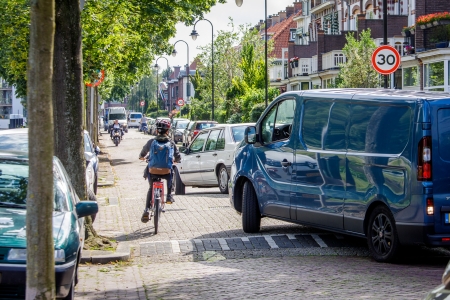Sustainable Safety can only effectively reduce the number of casualties if it is put into practice. It is therefore important to turn Sustainable Safety principles into measures. Two steps are needed:
Step 1 - from principles to requirements
First, the principles should be operationalized. This entails a clear description of the requirements our traffic system should meet: 'requirements for sustainable road safety'. These previous examples may be built on:
- Functional requirements for a sustainably safe infrastructure [57], among wich:
- make parts of routes on relatively unsafe roads as short as possible;
- make route length as short as possible;
- coincide shortest and safest route;
- prevent searching;
- make road categories recognizable.
- The official learning objectives for permanent road safety education for children and their attendants [58].
- The operational requirements for enforcement, see for example [59]:
- increase subjective probability of detection;
- ensure a high degree of confidence that a violation will be countered by a sanction;
- have sanction soon follow violation.
- Operational requirements from a psychological perspective, [19], among wich:
- restrict additional work load;
- timely present information;
- prioritize information according to relevance, dependent on context and urgency;
- prevent visual and auditory distraction from the driving task.
For the third edition of Sustainable Safety a number of these operational requirements still need to be elaborated on, to be appropriate to the present principles. These will, however, build on the previous requirements.
Step 2 - from requirements to measures
The operational requirements are at the basis of legislation and guidelines and, eventually, the measures needed. The Sustainable Safety principles of the third edition are worded in such a way that the conversion into measures is receptive to future developments. For example: by realising the physical and infrastructural separation of traffic modes and by enhancing recognition of road types now, future use of intelligent vehicle technology will be facilitated.
Aarts and Dijkstra [6] recommend the following Sustainable Safety measures:
- Start from an actual road safety problem (inherent unsafety, in particular if it concerns a large group of casualties).
- Find out which operational requirements might solve the problem; reviewing them in full (based on the various Sustainable Safety principles and elements of the traffic system).
- Take stock of the approaches to meet the operational requirement: approaches that fit within the Sustainable Safety vision in its entirety.
- Find out which actors have an impact on possible approaches and ensure a transparent allocation of responsibilities and tasks.
- Regularly monitor whether the measures have indeed been taken and have been effective.
Organizations that have an impact on road safety may adopt the abovementioned recommendations autonomously; it would also be appropriate that - in the same way as in the days of the Sustainable Safety Start-up programme - a coherent set of agreements is made by central and local governments and possibly other organizations to further implement Sustainable Safety measures. Subsequently, political policies and appropriate conditions will determine to what extent effective measures are put into actual practice [60].
